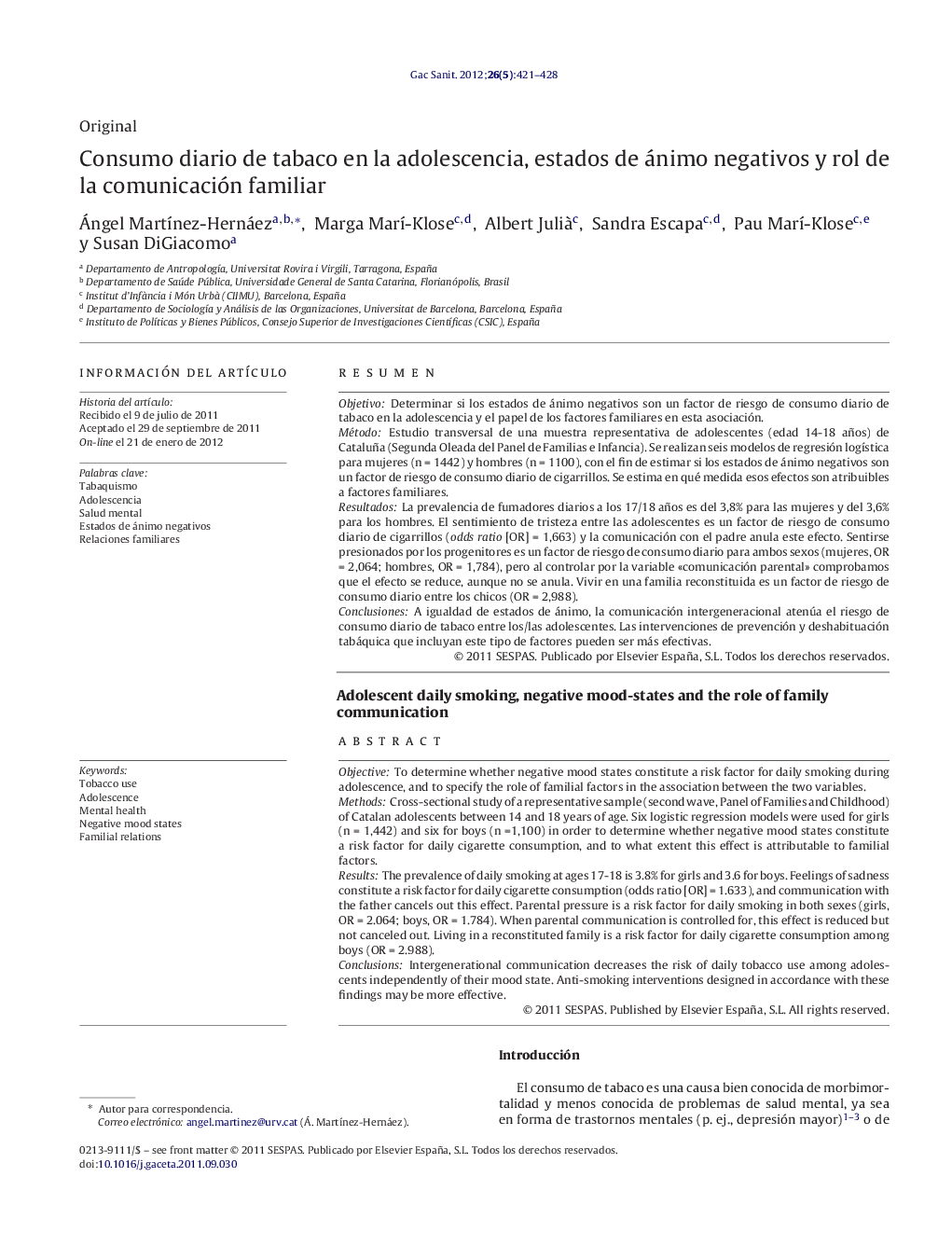| Article ID | Journal | Published Year | Pages | File Type |
|---|---|---|---|---|
| 1073807 | Gaceta Sanitaria | 2012 | 8 Pages |
ResumenObjetivoDeterminar si los estados de ánimo negativos son un factor de riesgo de consumo diario de tabaco en la adolescencia y el papel de los factores familiares en esta asociación.MétodoEstudio transversal de una muestra representativa de adolescentes (edad 14-18 años) de Cataluña (Segunda Oleada del Panel de Familias e Infancia). Se realizan seis modelos de regresión logística para mujeres (n = 1442) y hombres (n = 1100), con el fin de estimar si los estados de ánimo negativos son un factor de riesgo de consumo diario de cigarrillos. Se estima en qué medida esos efectos son atribuibles a factores familiares.ResultadosLa prevalencia de fumadores diarios a los 17/18 años es del 3,8% para las mujeres y del 3,6% para los hombres. El sentimiento de tristeza entre las adolescentes es un factor de riesgo de consumo diario de cigarrillos (odds ratio [OR] = 1,663) y la comunicación con el padre anula este efecto. Sentirse presionados por los progenitores es un factor de riesgo de consumo diario para ambos sexos (mujeres, OR = 2,064; hombres, OR = 1,784), pero al controlar por la variable «comunicación parental» comprobamos que el efecto se reduce, aunque no se anula. Vivir en una familia reconstituida es un factor de riesgo de consumo diario entre los chicos (OR = 2,988).ConclusionesA igualdad de estados de ánimo, la comunicación intergeneracional atenúa el riesgo de consumo diario de tabaco entre los/las adolescentes. Las intervenciones de prevención y deshabituación tabáquica que incluyan este tipo de factores pueden ser más efectivas.
ObjectiveTo determine whether negative mood states constitute a risk factor for daily smoking during adolescence, and to specify the role of familial factors in the association between the two variables.MethodsCross-sectional study of a representative sample (second wave, Panel of Families and Childhood) of Catalan adolescents between 14 and 18 years of age. Six logistic regression models were used for girls (n = 1,442) and six for boys (n =1,100) in order to determine whether negative mood states constitute a risk factor for daily cigarette consumption, and to what extent this effect is attributable to familial factors.ResultsThe prevalence of daily smoking at ages 17-18 is 3.8% for girls and 3.6 for boys. Feelings of sadness constitute a risk factor for daily cigarette consumption (odds ratio [OR] = 1.633), and communication with the father cancels out this effect. Parental pressure is a risk factor for daily smoking in both sexes (girls, OR = 2.064; boys, OR = 1.784). When parental communication is controlled for, this effect is reduced but not canceled out. Living in a reconstituted family is a risk factor for daily cigarette consumption among boys (OR = 2.988).ConclusionsIntergenerational communication decreases the risk of daily tobacco use among adolescents independently of their mood state. Anti-smoking interventions designed in accordance with these findings may be more effective.
